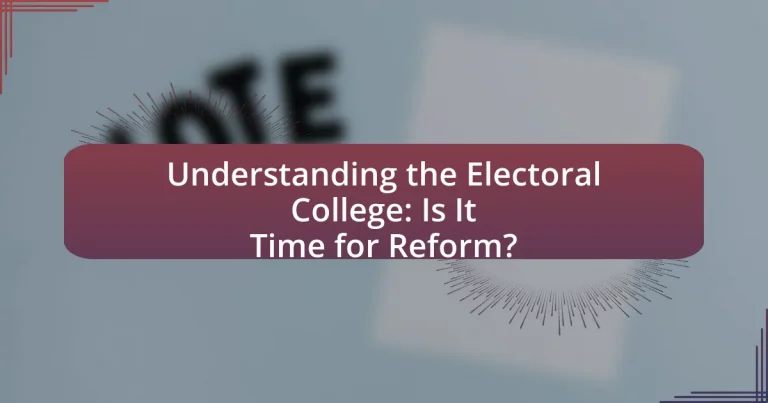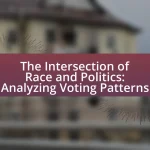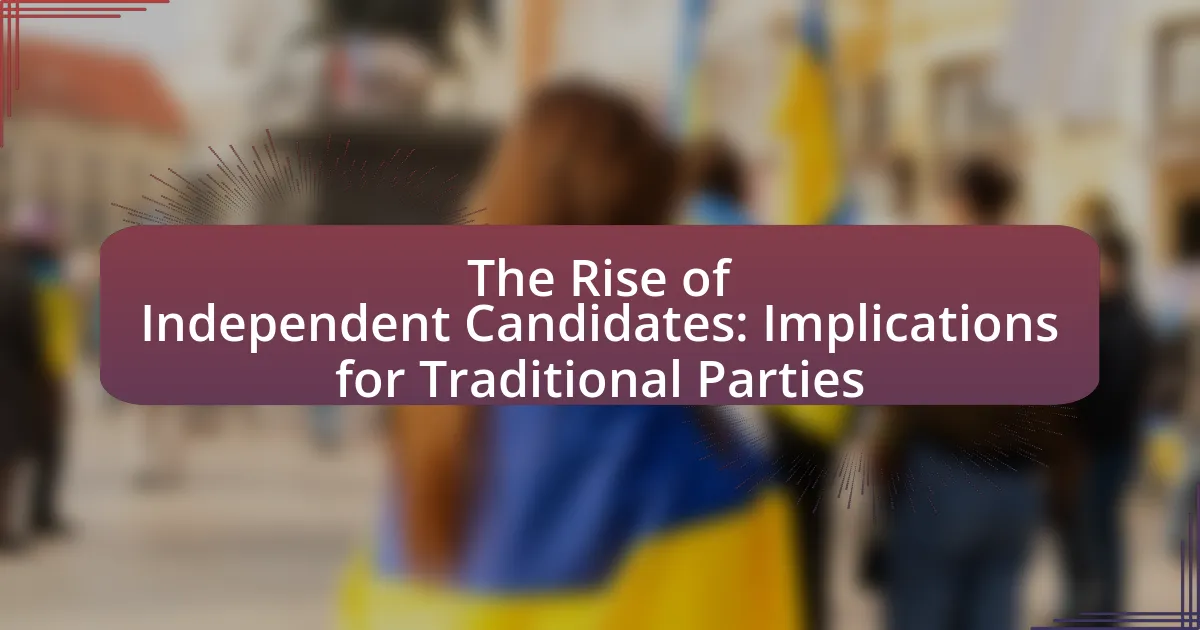The Electoral College is a constitutional mechanism for the indirect election of the President and Vice President of the United States, comprising 538 electors with a majority of 270 votes needed to win. Established in 1787, it was designed to balance the influence of populous and less populous states, reflecting the federal structure of the government. This article explores the historical context, functioning, advantages, and disadvantages of the Electoral College, as well as the ongoing calls for reform due to concerns about its fairness and representation of the popular vote. Key topics include the process of electing a president, the implications of the winner-takes-all system, and potential alternatives to the current electoral framework.

What is the Electoral College?
The Electoral College is a mechanism established by the United States Constitution for the indirect election of the president and vice president of the United States. It consists of 538 electors, with a majority of 270 electoral votes required to win the presidency. Each state is allocated a number of electors based on its representation in Congress, which is determined by the state’s population. This system was created to balance the influence of populous states with less populous ones in presidential elections, as outlined in Article II, Section 1 of the Constitution.
How was the Electoral College established?
The Electoral College was established by the United States Constitution in 1787 as a compromise between electing the president by a vote in Congress and by popular vote. The framers of the Constitution created this system to balance the influence of populous states with less populous ones, ensuring that all states had a role in the election process. Specifically, Article II, Section 1 of the Constitution outlines the mechanism for electing the president and vice president through electors chosen by each state, reflecting the federal structure of the government. This establishment aimed to create a buffer between the electorate and the selection of a president, addressing concerns about direct democracy and the potential for mob rule.
What historical context led to the creation of the Electoral College?
The creation of the Electoral College was influenced by the Founding Fathers’ concerns about direct democracy and the balance of power between populous and less populous states. During the Constitutional Convention of 1787, delegates debated how to elect the President, ultimately deciding that a compromise was necessary to ensure both representation and stability. This led to the establishment of the Electoral College as a mechanism to balance the influence of larger states with that of smaller ones, allowing each state to have a proportional yet controlled voice in presidential elections. The decision was rooted in the desire to prevent potential tyranny of the majority while still acknowledging the importance of popular support, reflecting the political landscape and regional interests of the time.
What were the founding fathers’ intentions behind the Electoral College?
The founding fathers intended the Electoral College to balance the influence of populous states with less populous ones in presidential elections. They designed it as a compromise between direct popular vote and election by Congress, aiming to ensure that all regions of the country had a voice in the selection of the president. This system was established in the U.S. Constitution, reflecting their concerns about direct democracy potentially leading to mob rule and the need for a mechanism that would consider both the will of the people and the interests of smaller states. The framers believed that electors, chosen by state legislatures, would be more informed and capable of making reasoned decisions, thus safeguarding the election process from potential populist excesses.
How does the Electoral College function in presidential elections?
The Electoral College functions by allocating a specific number of electors to each state, based on its representation in Congress, to formally elect the President and Vice President of the United States. Each state has a total number of electors equal to its number of Senators (always 2) plus its number of Representatives in the House, which varies according to the state’s population. In total, there are 538 electors, and a candidate needs a majority of 270 electoral votes to win the presidency.
During presidential elections, voters in each state cast their ballots for their preferred candidate, and the candidate receiving the majority of votes in that state typically receives all of its electoral votes, a system known as winner-takes-all, used by most states. This process culminates in the electors formally casting their votes in December, which are then counted by Congress in January, finalizing the election outcome. The Electoral College was established in the U.S. Constitution and has been a subject of debate regarding its effectiveness and fairness in representing the popular vote.
What is the process of electing a president through the Electoral College?
The process of electing a president through the Electoral College involves several key steps. First, citizens cast their votes in the presidential election, which occurs on the first Tuesday after the first Monday in November. These votes determine the electors pledged to each candidate in each state. Each state has a number of electors equal to its total number of Senators and Representatives in Congress, totaling 538 electors nationwide.
After the election, the electors meet in their respective state capitals in December to formally cast their votes for president and vice president. This meeting is governed by the Constitution and state laws. The results of this voting are then certified and sent to Congress. In January, during a joint session, Congress officially counts the electoral votes. A candidate must receive a majority of the electoral votes, at least 270, to win the presidency. This process is outlined in Article II of the U.S. Constitution and further clarified by the 12th Amendment.
How are electoral votes allocated to each state?
Electoral votes are allocated to each state based on its representation in Congress, which includes both the number of Senators and Representatives. Each state has two electoral votes corresponding to its two Senators, while the number of Representatives is determined by the state’s population, as measured by the decennial census. For example, California, with the largest population, has 55 electoral votes, while smaller states like Wyoming have 3 electoral votes. This allocation method is established by the U.S. Constitution and has been in place since the first presidential election in 1788.
What are the advantages and disadvantages of the Electoral College?
The Electoral College has advantages and disadvantages that impact the U.S. presidential election process. One advantage is that it protects the interests of smaller states by ensuring they have a proportional influence in elections, as seen in the allocation of electoral votes based on state populations. This system encourages candidates to campaign in less populous areas, promoting national unity. Conversely, a significant disadvantage is that it can lead to a situation where the candidate who wins the popular vote does not win the presidency, as occurred in the elections of 1824, 1876, 1888, 2000, and 2016. This discrepancy can undermine the democratic principle of one-person, one-vote, leading to public disillusionment with the electoral process.
What benefits does the Electoral College provide to the electoral process?
The Electoral College provides several benefits to the electoral process, including the promotion of a federal system of government and the encouragement of national campaigning. By allocating electoral votes based on state populations, the system ensures that smaller states retain a voice in presidential elections, preventing larger states from dominating the process. This structure fosters a balance between populous and less populous states, as seen in the 2016 election where candidates campaigned in diverse regions, addressing a variety of local issues. Additionally, the Electoral College incentivizes candidates to build broad coalitions across different states, which can lead to more inclusive governance.
What criticisms are commonly associated with the Electoral College?
Common criticisms associated with the Electoral College include its potential to undermine the principle of one-person, one-vote, as it can result in a candidate winning the presidency without securing the majority of the popular vote. For instance, in the elections of 1824, 1876, 1888, 2000, and 2016, candidates were elected despite losing the popular vote, highlighting a significant disparity between electoral and popular support. Additionally, the system disproportionately amplifies the influence of smaller states, as each state is allocated a minimum of three electoral votes regardless of population, leading to unequal representation. This has been criticized for diminishing the voting power of individuals in more populous states. Furthermore, the winner-takes-all approach used by most states can discourage voter turnout, as individuals in states perceived as solidly supporting one party may feel their votes carry less weight. These criticisms raise questions about the fairness and effectiveness of the Electoral College in reflecting the democratic will of the electorate.
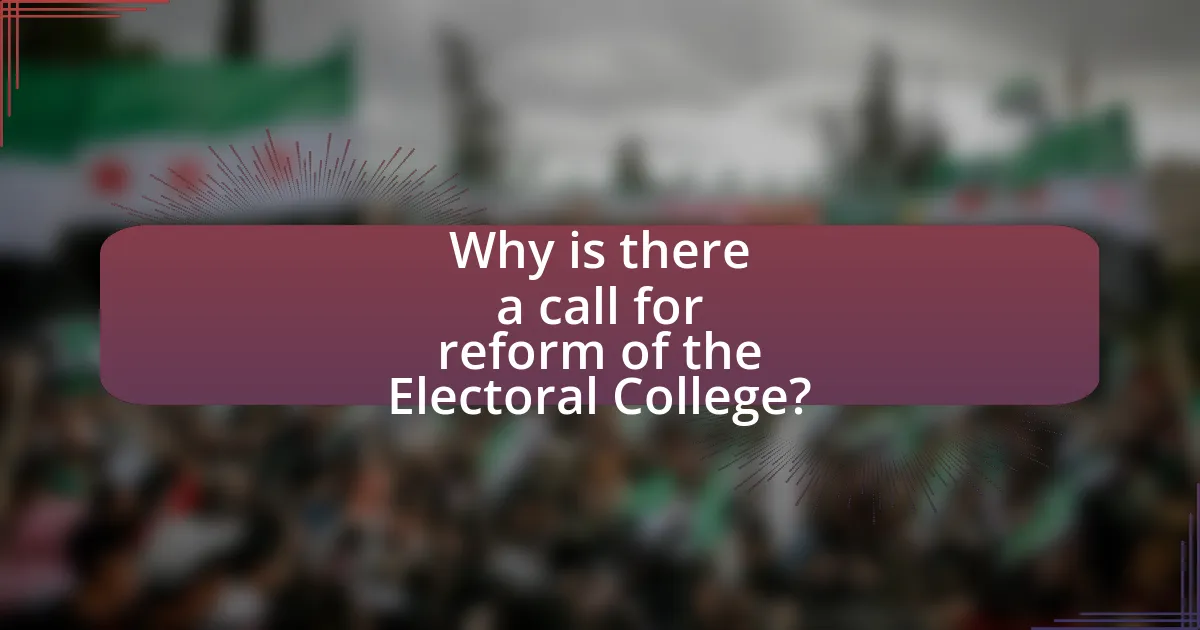
Why is there a call for reform of the Electoral College?
There is a call for reform of the Electoral College primarily because it can lead to the election of a president who does not win the popular vote, undermining democratic principles. For instance, in the elections of 1824, 1876, 1888, 2000, and 2016, candidates won the presidency while losing the nationwide popular vote, raising concerns about the system’s fairness and representation. Critics argue that this discrepancy diminishes the value of individual votes, particularly in states with a strong partisan majority, and disproportionately amplifies the influence of smaller states. These factors contribute to ongoing debates about whether the Electoral College effectively reflects the will of the American electorate.
What are the main arguments for reforming the Electoral College?
The main arguments for reforming the Electoral College include the disproportionate influence of smaller states, the potential for a candidate to win the presidency without winning the popular vote, and the discouragement of voter turnout in non-competitive states. The Electoral College allocates electors based on state population, but smaller states receive a minimum of three electors regardless of their population, leading to unequal representation. For instance, Wyoming has a significantly higher electoral vote per capita compared to California. Additionally, in five instances, including the elections of 1824, 1876, 1888, 2000, and 2016, candidates have won the presidency while losing the popular vote, raising concerns about democratic legitimacy. Furthermore, voters in states deemed “safe” for one party may feel their votes carry less weight, resulting in lower participation rates. These factors collectively argue for a reevaluation of the Electoral College system to enhance democratic representation and voter engagement.
How does the Electoral College impact voter representation?
The Electoral College significantly impacts voter representation by creating a system where the weight of individual votes varies by state, leading to unequal representation. For instance, smaller states have a disproportionately higher number of electoral votes relative to their population size, meaning that a vote in Wyoming carries more weight than a vote in California. This discrepancy arises because the minimum number of electoral votes for a state is three, regardless of population, which skews the representation in favor of less populous states. According to the U.S. Census Bureau, this results in a situation where voters in states with smaller populations have a greater influence on the outcome of presidential elections compared to voters in larger states, thereby undermining the principle of one-person, one-vote.
What are the implications of the winner-takes-all system?
The implications of the winner-takes-all system include the concentration of political power in a few states and the marginalization of voters in states with predictable outcomes. This system, used by most states in the Electoral College, means that the candidate who receives the majority of votes in a state secures all of its electoral votes, effectively diminishing the influence of minority party voters. For instance, in the 2016 presidential election, Donald Trump won all of Michigan’s 16 electoral votes despite winning the state by a narrow margin of about 10,000 votes, illustrating how close elections can lead to significant disparities in electoral representation. This system can lead to candidates focusing their campaigns on swing states while ignoring those with a strong partisan leaning, which can exacerbate regional inequalities and voter disenfranchisement.
What are the potential consequences of reforming the Electoral College?
Reforming the Electoral College could lead to significant changes in the American electoral process, including a shift towards a more direct democracy. This reform may result in increased voter participation, as a popular vote system could encourage more citizens to engage in elections, knowing their votes carry equal weight nationwide. Additionally, it could diminish the influence of swing states, leading to a more uniform campaign strategy across the country, as candidates would need to appeal to a broader electorate rather than focusing on a few battleground states. Historical context shows that the current system can lead to outcomes where the winner of the popular vote does not win the presidency, as seen in the elections of 2000 and 2016, which raises questions about the legitimacy of the electoral process. Furthermore, reforming the Electoral College could exacerbate regional disparities in political representation, as urban areas might gain more influence at the expense of rural regions.
How might reform affect future presidential elections?
Reform could significantly alter future presidential elections by changing how electoral votes are allocated and potentially increasing voter participation. For instance, implementing a national popular vote system would ensure that every vote carries equal weight, contrasting with the current Electoral College system where votes are not uniformly represented across states. Historical data shows that in the 2000 and 2016 elections, candidates won the presidency without winning the popular vote, highlighting the discrepancies in representation. Additionally, reforms aimed at reducing voter suppression and enhancing access to voting could lead to higher turnout rates, thereby influencing election outcomes and candidate strategies.
What alternative systems are proposed to replace the Electoral College?
Alternative systems proposed to replace the Electoral College include the National Popular Vote Interstate Compact (NPVIC), ranked-choice voting, and proportional allocation of electoral votes. The NPVIC aims to ensure that the candidate receiving the most popular votes nationwide wins the presidency by having participating states agree to award their electoral votes to the national popular vote winner. Ranked-choice voting allows voters to rank candidates in order of preference, which can lead to a more representative outcome. Proportional allocation of electoral votes would distribute electoral votes based on the percentage of votes each candidate receives in a state, rather than the winner-takes-all approach currently used by most states. These alternatives are discussed in various reform proposals and academic analyses, highlighting their potential to create a more equitable electoral process.
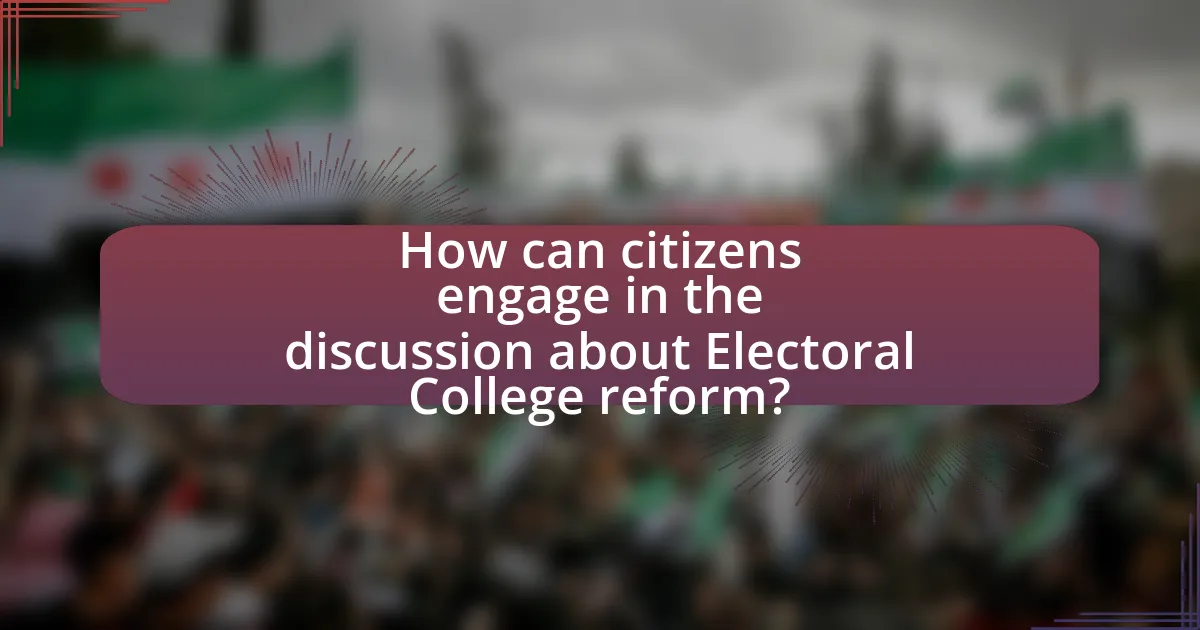
How can citizens engage in the discussion about Electoral College reform?
Citizens can engage in the discussion about Electoral College reform by participating in public forums, contacting their elected representatives, and joining advocacy groups focused on electoral reform. Public forums, such as town hall meetings or community discussions, provide platforms for citizens to express their views and learn from others. Contacting elected representatives allows citizens to voice their opinions directly to decision-makers, influencing potential legislative changes. Additionally, joining advocacy groups, such as the National Popular Vote movement, enables citizens to collaborate with like-minded individuals and amplify their efforts for reform. These methods are effective as they foster dialogue and raise awareness about the implications of the Electoral College system.
What actions can individuals take to advocate for reform?
Individuals can advocate for reform by engaging in grassroots organizing, contacting elected officials, and participating in public forums. Grassroots organizing involves mobilizing community members to raise awareness about the need for reform, which can lead to increased public support and pressure on policymakers. Contacting elected officials through emails, phone calls, or letters allows individuals to express their views directly and urge them to support specific reforms, such as changes to the Electoral College system. Participating in public forums, town hall meetings, or debates provides a platform for individuals to voice their opinions and influence public discourse on electoral reform. These actions are supported by historical examples where citizen advocacy has led to significant policy changes, demonstrating the power of collective action in shaping democratic processes.
How can citizens participate in local and national discussions on this topic?
Citizens can participate in local and national discussions on the topic of the Electoral College by engaging in public forums, attending town hall meetings, and utilizing social media platforms to express their views. Public forums and town hall meetings often provide opportunities for citizens to voice their opinions directly to elected officials and engage in dialogue about electoral reform. Additionally, social media platforms allow for widespread dissemination of ideas and facilitate discussions among diverse groups, making it easier for citizens to connect with others who share similar concerns or viewpoints. According to a 2020 Pew Research Center study, 69% of Americans believe that social media is an important tool for political engagement, highlighting its role in fostering discussions on topics like the Electoral College.
What resources are available for educating oneself and others about the Electoral College?
Resources available for educating oneself and others about the Electoral College include academic articles, government websites, and educational organizations. For instance, the National Archives and Records Administration provides comprehensive information on the history and function of the Electoral College. Additionally, the American Bar Association offers resources that explain the legal aspects and implications of the Electoral College. Educational platforms like Khan Academy and Coursera also feature courses that cover the electoral process, including the Electoral College, providing structured learning opportunities. These resources are validated by their authoritative nature and the expertise of the organizations involved.
What are the best practices for discussing the Electoral College with others?
The best practices for discussing the Electoral College with others include being informed about its history, structure, and function, as well as encouraging open dialogue and respectful debate. Understanding that the Electoral College was established by the U.S. Constitution in 1787 to balance the influence of populous states with less populous ones is crucial for context. Engaging others by asking questions can foster a more productive conversation, allowing participants to express their views while also considering different perspectives. Additionally, using credible sources, such as academic articles or government reports, can support arguments and clarify misconceptions, as evidenced by the National Archives’ explanation of the Electoral College’s role in presidential elections.
How can one effectively communicate the pros and cons of the Electoral College?
To effectively communicate the pros and cons of the Electoral College, one should present a balanced analysis that highlights both its advantages and disadvantages. The pros include the protection of minority interests by ensuring that less populous states have a voice in presidential elections, as evidenced by the fact that smaller states receive a minimum of three electoral votes regardless of population size. Conversely, the cons involve the potential for a candidate to win the presidency without securing the popular vote, which has occurred in instances such as the elections of 1824, 1876, 1888, 2000, and 2016. This discrepancy can lead to public disillusionment with the electoral process. By using clear examples and historical context, one can effectively convey the complexities of the Electoral College system.
What strategies can be used to engage skeptics in meaningful dialogue?
To engage skeptics in meaningful dialogue, one effective strategy is to actively listen and validate their concerns. This approach fosters an environment of respect and openness, encouraging skeptics to share their viewpoints without feeling dismissed. Research indicates that when individuals feel heard, they are more likely to engage constructively in discussions. For instance, a study published in the Journal of Communication found that empathetic listening can significantly reduce defensiveness and promote collaborative dialogue. Additionally, presenting evidence-based information in a clear and relatable manner can help bridge gaps in understanding, as demonstrated by the success of educational initiatives that incorporate storytelling to convey complex topics like the Electoral College.
